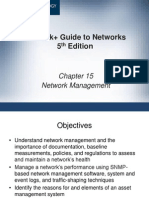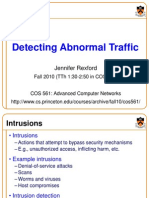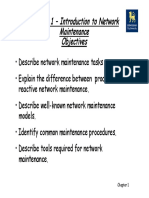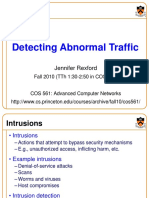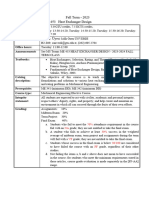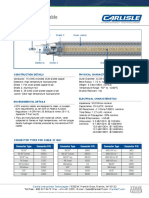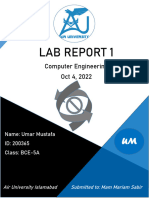Network Monitoring and
Management
Introduction to Networking
Monitoring and Management
These materials are licensed under the Creative Commons Attribution-Noncommercial 3.0 Unported license
(http://creativecommons.org/licenses/by-nc/3.0/) as part of the ICANN, ISOC and NSRC Registry Operations Curriculum.
�Part I: Overview
Core concepts presented:
What is network monitoring
What is network management
Getting started
Why network management
The big three
Attack detection
Documentation
Consolidating the data
The big picture
�Network Management Details
We Monitor
System & Services
Available, reachable
Resources
Expansion planning, maintain availability
Performance
Round-trip-time, throughput
Changes and configurations
Documentation, revision control, logging
�Network Management Details
We Keep Track Of
Statistics
For purposes of accounting and metering
Faults (Intrusion Detection)
Detection of issues,
Troubleshooting issues and tracking their history
Ticketing systems are good at this
Help Desks are a useful to critical component
�Expectations
A network in operation needs to be monitored
in order to:
- Deliver
projected SLAs (Service Level
Agreements)
- SLAs depend on policy
What does your management expect?
What do your users expect?
What do your customers expect?
What does the rest of the Internet expect?
- Whats
good enough? 99.999% Uptime?
There's no such thing as 100% uptime (as well see)
�Uptime Expectations
What does it take to deliver 99.9 % uptime?
30.5 days x 24 hours = 732 hours a month
(732 (732 x .999)) x 60 = 44 minutes
only 44 minutes of downtime a month!
Need to shutdown 1 hour / week?
(732 4) / 732x 100 = 99.4 %
Remember to take planned maintenance into account in your
calculations, and inform your users/customers if they are
included/excluded in the SLA
How is availability measured?
In the core? End-to-end? From the Internet?
�Baselining
What is normal for your network?
If youve never measured or monitored your
network you will need to know things like:
Typical load on links ( Cacti)
Level of jitter between endpoints ( Smokeping)
Typical percent usage of resources
Typical amounts of noise:
Network scans
Dropped data
Reported errors or failures
�Why do all this?
Know when to upgrade
-
-
-
-
Is your bandwidth usage too high?
Where is your traffic going?
Do you need to get a faster line, or more providers?
Is the equipment too old?
Keep an audit trace of changes
-
-
Record all changes
Makes it easier to find cause of problems due to
upgrades and configuration changes
Keep a history of your network operations
Using a ticket system lets you keep a history of events.
Allows you to defend yourself and verify what happened
�Why network management?
Accounting
Track usage of resources
Bill customers according to usage
Know when you have problems
-
-
Stay ahead of your users! Makes you look good.
Monitoring software can generate tickets and automatically notify staff of issues.
Trends
All of this information can be used to view trends
across your network.
This is part of baselining, capacity planning and
attack detection.
�The Big Three?
Availability
Nagios
Services, servers, routers,
switches
Reliability
Smokeping Connection health, rtt, service
response time, latency
Performance
Cacti
Total traffic, port usage, CPU
RAM, Disk, processes
Functional overlap exists between these programs!
�Attack Detection
Trends and automation allow you to know
when you are under attack.
The tools in use can help you to mitigate
attacks:
Flows across network interfaces
Load on specific servers and/or services
Multiple service failures
�Consolidating the data
The Network Operations Center (NOC)
Where it all happens
- Coordination of tasks
- Status of network and services
- Fielding of network-related incidents and
complaints
- Where the tools reside (NOC server)
- Documentation including:
Network diagrams
database/flat file of each port on each switch
Network description
Much more as you'll see.
�The big picture
Notifications
- Monitoring
- Data collection
- Accounting
Ticket
- Change control &
monitoring
- NOC Tools
- Ticket system
Ticket
Ticket
- Improvements
- Upgrades
Ticket
Ticket
- User complaints
- Requests
- Fix problems
- Capacity planning
- Availability (SLAs)
- Trends
- Detect problems
�A few Open Source solutions
Performance
Cricket
IFPFM
flowc
mrtg*
NetFlow*
NfSen*
ntop
perfSONAR
pmacct
rrdtool*
SmokePing*
Ticketing
RT*
Trac*
Redmine
Change Mgmt
Mercurial
Rancid* (routers)
CVS*
Subversion*
git*
Security/NIDS
Nessus
OSSEC
Prelude
Samhain
SNORT
Untangle
Logging
swatch*
syslog/rsyslog*
tenshi*
Net Management
Big Brother
Big Sister
Cacti*
Hyperic
Munin
Nagios*
OpenNMS*
Sysmon
Zabbix
Documentation
IPplan
Netdisco
Netdot*
Rack Table
Protocols/Utilities
SNMP*, Perl, ping
�Questions?
�Part II: Details
Some details on the core concepts:
Network documentation continued
Diagnostic tools
Monitoring tools
Performance tools
Active and passive tools
SNMP
Ticket systems
Configuration and change management
�Questions?
�Part III: Details
Some details on the core concepts:
Diagnostic tools
Monitoring tools
Performance tools
Active and passive tools
SNMP
Ticket systems
Configuration and change management
�Network monitoring systems & tools
Three kinds of tools
1.
Diagnostic tools used to test connectivity,
ascertain that a location is reachable, or a
device is up usually active tools
2.
Monitoring tools tools running in the
background (daemons or services), which
collect events, but can also initiate their own
probes (using diagnostic tools), and recording
the output, in a scheduled fashion.
�Network monitoring systems & tools
3. Performance Tools
Key is to look at each router interface (probably
dont need to look at switch ports).
Two common tools:
-Netflow/NfSen: http://nfsen.sourceforge.net/
-MRTG:
http://oss.oetiker.ch/mrtg/
MRTG = Multi
Router Traffic
Grapher
�Network monitoring systems & tools
Active tools
-
-
-
-
Ping test connectivity to a host
Traceroute show path to a host
MTR combination of ping + traceroute
SNMP collectors (polling)
Passive tools
-
log monitoring, SNMP trap receivers, NetFlow
Automated tools
-
-
SmokePing record and graph latency to a set of hosts,
using ICMP (Ping) or other protocols
MRTG/RRD record and graph bandwidth usage on a
switch port or network link, at regular intervals
�Network monitoring systems & tools
Network & Service Monitoring tools
-
-
-
Nagios server and service monitor
Can monitor pretty much anything
HTTP, SMTP, DNS, Disk space, CPU usage, ...
Easy to write new plugins (extensions)
Basic scripting skills are required to develop simple
monitoring jobs Perl, Shell scripts, php, etc...
Many good Open Source tools
Zabbix, ZenOSS, Hyperic, OpenNMS ...
Use them to monitor reachability and
latency in your network
-
Parent-child dependency mechanisms are very useful!
�Network monitoring systems & tools
Monitor your critical Network Services
-
-
-
DNS/Web/Email
Radius/LDAP/SQL
SSH to routers
How will you be notified?
Don't forget log management!
-
-
-
Every network device (and UNIX and Windows servers
as well) can report system events using syslog
You MUST collect and monitor your logs!
Not doing so is one of the most common mistakes when
doing network monitoring
�Network management protocols
SNMP Simple Network Management
Protocol
Industry standard, hundreds of tools exist to exploit it
- Present on any decent network equipment
Network throughput, errors, CPU load, temperature, ...
-
UNIX and Windows implement this as well
Disk space, running processes, ...
SSH and telnet
-
It is also possible to use scripting to automate
monitoring of hosts and services
�SNMP tools
Net SNMP tool set
- http://net-snmp.sourceforge.net/
Very simple to build simple tools
-
One that builds snapshots of which IP is used by which
Ethernet address
Another that builds shapshots of which Ethernet
addresses exist on which port on which switch.
Query remote RAID array for state.
Query server, switches and routers for temperatures.
Etc
�Statistics and accounting tools
Traffic accounting and analysis
- What
is your network used for, and how much
- Useful for Quality of Service, detecting abuses,
and billing (metering)
- Dedicated protocol: NetFlow
- Identify traffic flows: protocol, source,
destination, bytes
- Different tools exist to process the information
Flowtools, flowc
NFSen
Many more: http://www.networkuptime.com/tools/netflow/
�Fault and problem management
Is the problem transient?
-
Overload, temporary resource shortage
Is the problem permanent?
-
Equipment failure, link down
How do you detect an error?
-
-
Monitoring!
Customer complaints
A ticket system is essential
-
-
Open ticket to track an event (planned or failure)
Define dispatch/escalation rules
Who handles the problem?
Who gets it next if no one is available?
�Ticketing systems
Why are they important?
-
Track all events, failures and issues
Focal point for helpdesk communication
Use it to track all communications
-
Both internal and external
Events originating from the outside:
-
customer complaints
Events originating from the inside:
-
System outages (direct or indirect)
Planned maintenances or upgrades Remember to
notify your customers!
�Ticketing systems
Use ticket system to follow each case,
including internal communication between
technicians
Each case is assigned a case number
Each case goes through a similar life cycle:
- New
- Open
- ...
- Resolved
- Closed
�Ticketing systems
Workflow:
Ticket System
Helpdesk
Tech
Eqpt
---------------------------------------------------------------T
T
T
T
query
|
|
|
|
from ---->|
|
|
|
customer
|--- request --->|
|
|
<- ack. -- |
|
|
|
|
|<-- comm -->
|
|
|
|
|- fix issue -> eqpt
|
|<- report fix -|
|
customer <-|<-- respond ----|
|
|
|
|
|
|
�Ticketing systems: examples
rt (request tracker)
-
-
-
-
trac
-
-
-
Heavily used worldwide.
A classic ticketing system that can be customized to
your location.
Somewhat difficult to install and configure.
Handles large-scale operations.
A hybrid system that includes a wiki and project
management features.
Ticketing system is not as robust as rt, but works well.
Often used for tracking group projects.
redmine
-
Like trac, but more robust. Harder to install
�Network Intrusion Detection
Systems (NIDS)
These are systems that observe all of your network
traffic and report when it sees specific kinds of
problems, such as:
-
hosts that are infected or are acting as spamming sources.
A few tools:
-
SNORT - a commonly used open source tool:
http://www.snort.org/
Prelude Security Information Management System
https://dev.prelude-technologies.com/
Samhain Centralized HIDS
http://la-samhna.de/samhain/
Nessus - scan for vulnerabilities:
http://www.nessus.org/download/
�Configuration mgmt & monitoring
Record changes to equipment configuration using
revision control (also for configuration files)
Inventory management (equipment, IPs,
interfaces)
Use versioning control
-
As simple as:
cp named.conf named.conf.20070827-01
For plain configuration files:
-
-
CVS, Subversion (SVN)
Mercurial
For routers:
- RANCID
�Configuration mgmt & monitoring
Traditionally, used for source code (programs)
Works well for any text-based configuration files
-
For network equipment:
-
Also for binary files, but less easy to see differences
RANCID (Automatic Cisco configuration retrieval and
archiving, also for other equipment types)
Built-in to Project Management Software like:
-
-
-
Trac
Redmine
And, many other wiki products. Excellent for
documenting your network.
�The big picture revisited
Notifications
- Monitoring
- Data collection
- Accounting
Ticket
- Change control &
monitoring
- NOC Tools
- Ticket system
Ticket
Ticket
- Improvements
- Upgrades
Ticket
Ticket
- User complaints
- Requests
- Fix problems
- Capacity planning
- Availability (SLAs)
- Trends
- Detect problems
�Questions




















